When it comes to recording vocals and acoustic instruments (whether you’re doing it yourself or producing someone else), having the right mic is make-or-break, for real.
A lot of mics can sound super harsh, don’t have the desired warmth, and stink when it comes to isolating the voice from background noise.
To get solid results like I know you want, you need a mic that’s on-point, reliable, and able to really capture even the littlest details.
This way, your vocals and acoustic instruments will always sound clear, professional, and as close to perfect as possible.
But the problem is, many mics on the market don’t really hit the mark, even when they claim to.
That’s why we’re breaking down the best mics for recording (all budgets) 一 each one has features/functions designed to elevate your recordings, such as:
- Versatile polar patterns ✓
- High SPL handling ✓
- Built-in shock mounts ✓
- Low self-noise levels ✓
- Warm, detailed mids ✓
- USB and XLR connectivity options ✓
- Internal preamps for boosted gain ✓
- Multiple voicing modes ✓
- Superior off-axis rejection ✓
- Much more ✓
All of these mics are highly rated and tested for different recording setups.
And, we’re covering all types (condenser mics, dynamic mics, ribbon mics, and USB mics and more), so you’ll find the perfect fit for your recording needs.
This ensures that your vocals or instruments always sound authentic and refined.
Whether you’re tracking solo vocals, managing multiple instruments, or dealing with whack acoustic spaces, we’ve got you covered.
And yes, I’ve personally used each and every best mic for recording, so you’re getting the REAL inside scoop.
Table of Contents
- The Best Mics For Recording (Categorized)
- Condenser Microphones
- #1. Neumann U87 Ai ($3,600)
- #2. Neumann TLM 103 ($1,200)
- #3. AKG C414 XLII ($1,500)
- #4. Aston Spirit ($450)
- #5. Audio-Technica AT4050 ($699)
- #6. Rode NT1-A ($229)
- #7. sE Electronics sE2200 ($299)
- #8. UA Sphere DLX ($1,499)
- Best Dynamic Microphones for Recording
- #1. Shure SM7B ($399)
- #2. Sennheiser MD421-II ($379)
- #3. Electro-Voice RE20 ($499)
- #4. Shure SM58 (~$100)
- Best Tube Microphones
- #1. Neumann U67 Reissue ($7,400)
- #2. Rode NTK ($599)
- Best Ribbon Microphone: Royer R-121 ($1,495)
- Best USB Microphone: Shure MV7 ($279)
- Best Mic for Recording: Final Thoughts
The Best Mics For Recording (Categorized)
Like I said, we’re breaking down all the best mics for recording in different categories. Let’s kick things off with some of my favorite condenser mics and take it from there.
Condenser Microphones
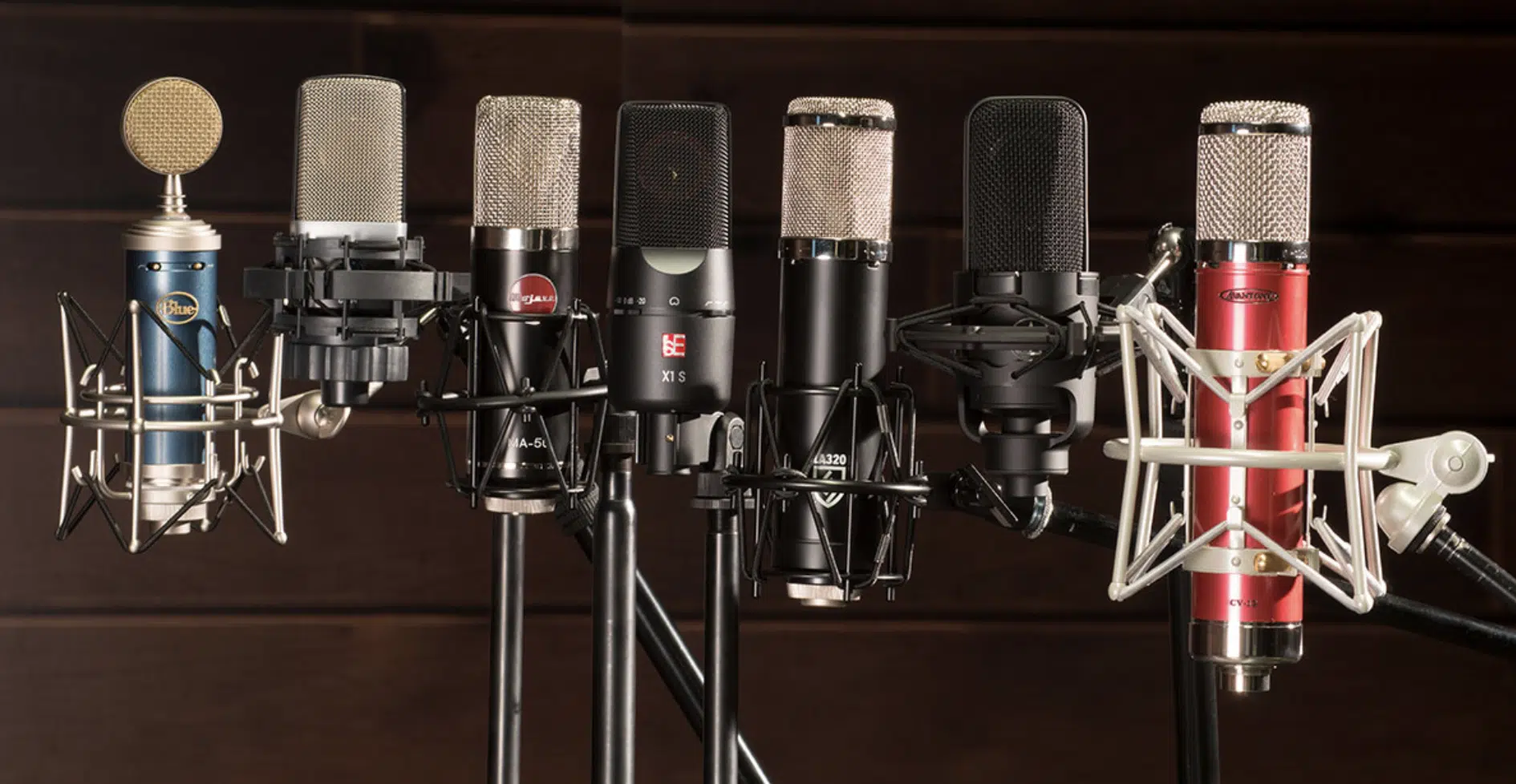
Condenser microphones are all about capturing clarity and enhancing detail in your recordings. They can help you achieve a natural, transparent sound and capture tiny nuances like a true professional. With their sensitivity and epic frequency response, they’re ideal for recording vocals, acoustic guitars, and other sensitive instruments where precision and texture are essential. Let’s get into it.
#1. Neumann U87 Ai ($3,600)
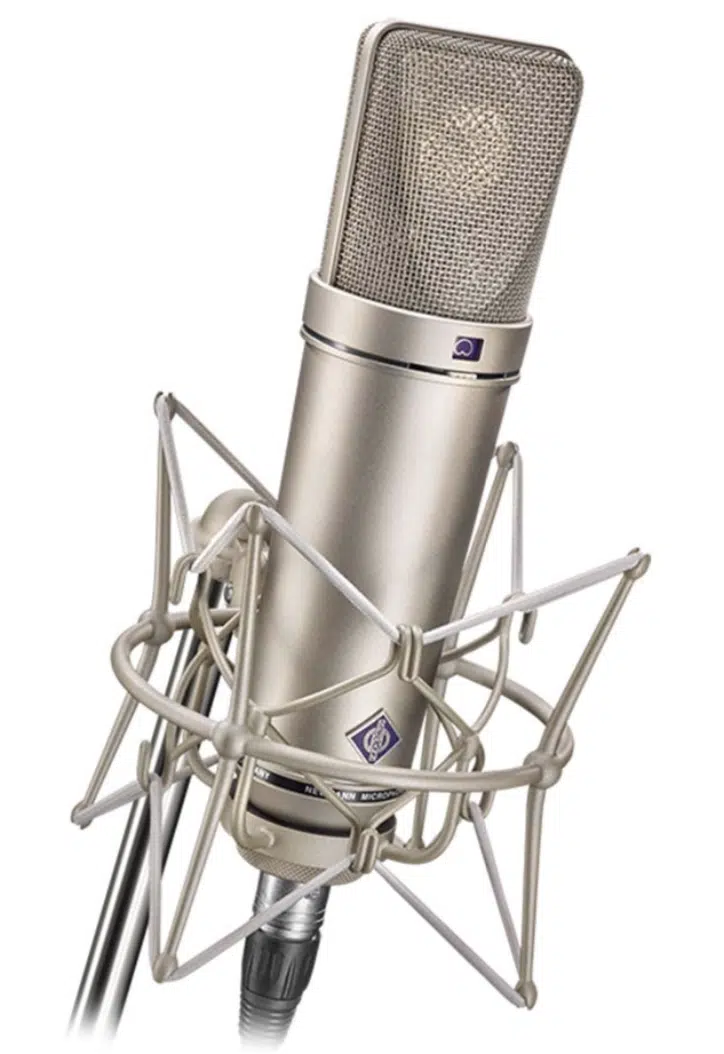
If you’re serious about studio recording, the Neumann U87 Ai is one mic you’ll want to get familiar with.
It’s been a benchmark in recording studios since 1967, and there’s a good reason why.
When I first tried it, I immediately noticed the smooth mids and airy highs that make vocals sound rich and full; it’s pretty epic.
It has three polar patterns (cardioid, omnidirectional, and figure-8) so it’s certainly versatile enough for different recording needs, from solo vocals to room ambiance.
The U87 Ai’s large diaphragm ensures precise sound capture, and its sensitivity is impressive, but keep in mind that also means it can pick up a lot of room noise.
The self-noise is low (12-15 dBA), so you get a clear, professional sound, but I’d recommend using it in a treated recording studio to avoid picking up unwanted noise.
It’s not cheap, that’s for sure, but it’s truly a one-time investment 一 considering its durability and ability to deliver authentic sound quality.
It’s fantastic for vocals, but I’ve also found it works wonders on acoustic guitars and spoken word, so it’s a solid choice all around.
Best Features of this Condenser Microphone
- Large dual-diaphragm design with three polar patterns (cardioid, omni, figure-8)
- Warm, balanced mids with a crisp high-end
- Low self-noise, but sensitive to room noise, making it ideal for treated studios
- Switchable -10 dB pad for louder sources, like powerful vocals or guitar amps
- Versatile across genres and applications
- Compatible with any audio interface
- The best mic for recording vocals, offering clear, natural sound quality that’s hard to beat
#2. Neumann TLM 103 ($1,200)
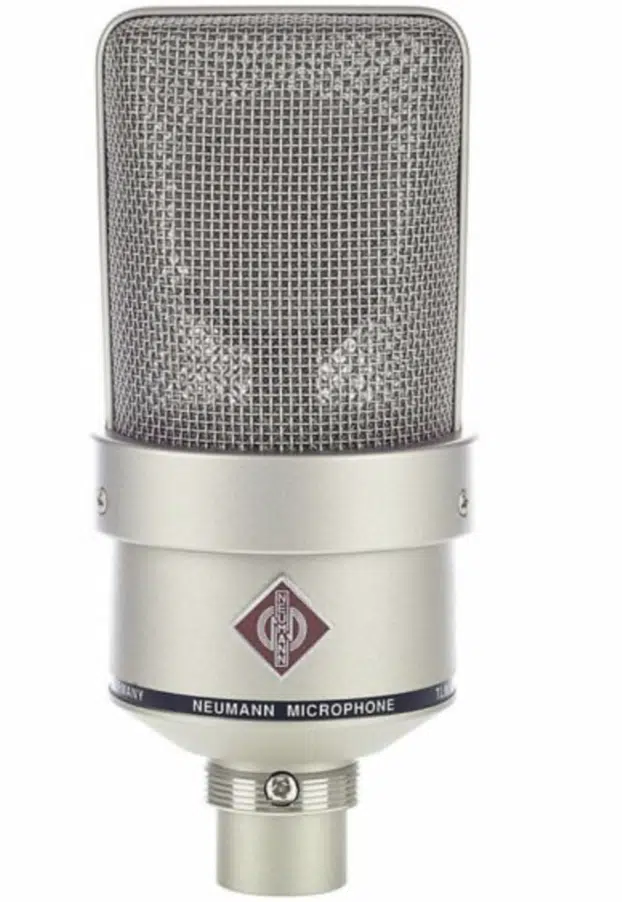
The TLM 103 is another banger by Neumann; a large-diaphragm condenser mic often described as a “modern version” of the iconic U87, but with a slightly more affordable price tag.
I’ve found it to be a very flexible mic for studio vocals, acoustic guitars, and even podcasts/broadcasting (thanks to its clean, direct sound).
It features a single cardioid polar pattern, focusing on sound sources directly in front of it while rejecting off-axis noise, so it’s great for isolating vocals.
With a frequency range of 20 Hz – 20 kHz and a max SPL of 138 dB, it can handle anything from soft whispers to loud drums without distortion.
Its sensitivity is rated at 23 mV/Pa, and it has a super low self-noise of just 7 dBA, which makes it one of the quietest condenser mics out there.
Perfect for capturing the finer details of a performance, which is key.
I also love how it maintains a warm midrange with a subtle presence boost above 5 kHz 一 making your vocals pop in the mix.
The lack of additional polar patterns might be a limitation for some, but I personally appreciate that it’s top-notch at delivering clear, authentic sound.
Best Features of this Condenser Microphone
- Large diaphragm with cardioid polar pattern for focused recordings
- Ultra-low self-noise of 7 dBA, ideal for capturing fine details in a quiet studio
- High sensitivity and broad frequency range (20 Hz – 20 kHz)
- Handles up to 138 dB SPL, suitable for loud vocals and instruments
- Warm midrange with a gentle presence boost above 5 kHz
- The best mic for recording clean vocals in a home studio or professional setup
#3. AKG C414 XLII ($1,500)
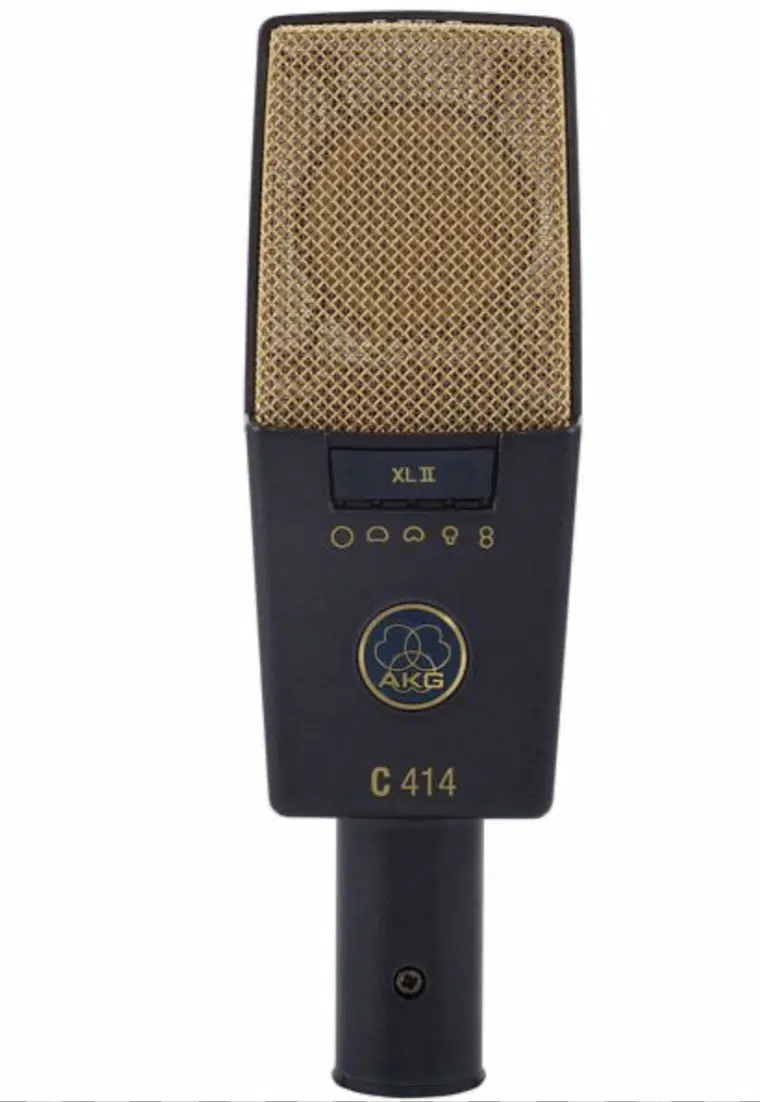
The AKG C414 XLII is a beast in the studio (professional studio and any home studio, too), known for its iconic sound.
And if we’re talking adaptability, it does not fall short, thanks to its nine selectable polar patterns, including:
- Cardioid
- Omnidirectional
- Figure-8
Whether you’re recording vocals, acoustic instruments, or even drum overheads on a drum kit, it can certainly get the job done.
The frequency range is a broad 20 Hz – 20 kHz, with a slight boost around 3 kHz to enhance vocal presence.
I’ve found this vocal microphone to be super helpful when you need clear highs and rich mids 一 giving vocals a touch of brightness without sounding too harsh or obnoxious.
The max SPL is 158 dB with the pad engaged, so it’s solid when it comes to handling everything from delicate vocals to loud guitar amps, which is great.
It also features a -6 dB, -12 dB, and -18 dB pad, as well as three switchable low-cut filters to minimize rumble and background noise (which it excels at).
One of my favorite things about this condenser mic is its versatility…
Whether I’m recording vocals up close or capturing room ambiance, the C414 XLII consistently delivers a detailed, balanced sound.
Overall, I’d definitely say it has an edge over other mics in its price range.
Best Features of this Condenser Microphone
- Nine selectable polar patterns for versatile recording options
- Broad frequency range (20 Hz – 20 kHz) with a presence boost around 3 kHz
- High max SPL (158 dB) with three levels of pad (-6, -12, -18 dB)
- Switchable low-cut filters for rejecting room noise
- Detailed, balanced sound across vocals and acoustic instruments
- The best mic for recording versatile studio vocals and instruments, providing exceptional clarity
#4. Aston Spirit ($450)
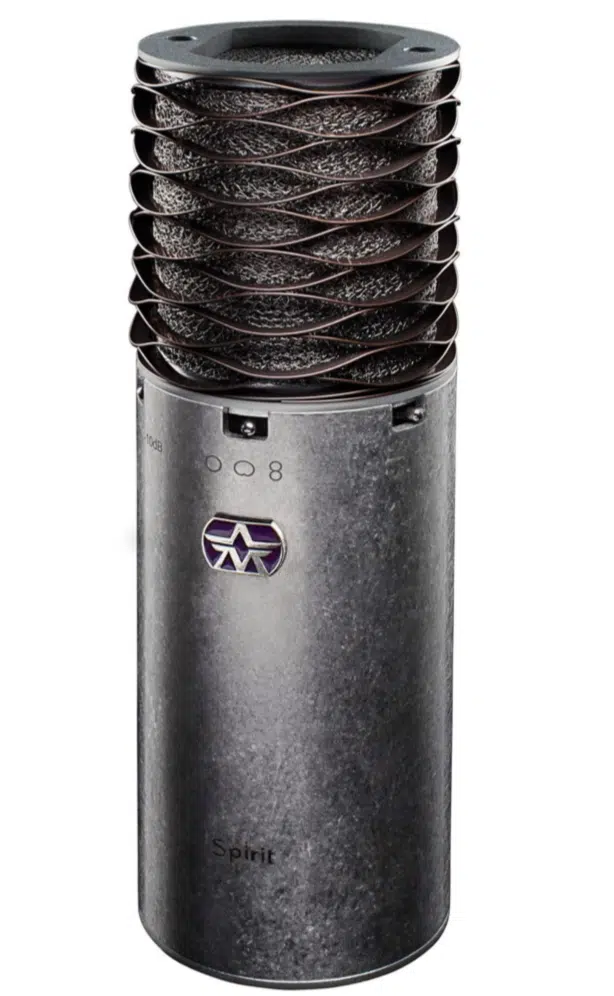
If you’re looking for budget-friendly large-diaphragm condenser mics, the Aston Spirit is one of my absolute favs.
Its warm, detailed sound is actually pretty impressive, especially given that it’s under 500 bucks, which honestly surprised me.
This condenser mic also features three polar patterns (cardioid, omnidirectional, and figure-8) so it’s flexible for various recording settings.
With a frequency response of 20 Hz – 20 kHz, the Spirit offers a slight presence boost around 10 kHz in cardioid and omni modes.
I noticed that it gives vocals a nice “air” without being harsh.
NOTE: Its capsule design uses a 1-inch gold-evaporated diaphragm, which is rare in this price range and adds to its clear, open sound.
Plus it can handle a maximum SPL of 138 dB, so it’s perfect for both quiet vocals and louder acoustic instruments.
One thing I find impressive is its built-in pop filter, which helps reduce plosives, and its -10 dB and -20 dB pad switch for louder sound sources.
Along with the 80 Hz low-pass filter to minimize background noise too, of course, so even without a shock mount it’s pretty impressive.
The Spirit’s rugged stainless-steel body gives it a distinctive ‘steampunk’ look, and it feels durable in hand.
Again, it does lack a bundled shock mount, but its built-in vibration isolation and wave-form mesh head design does a solid job at reducing handling noise.
So, for the price, I’d say you can’t really beat it if you’re on a budget.
Best Features of this Condenser Microphone
- Large diaphragm with three polar patterns (omni, cardioid, figure-8)
- Frequency response of 20 Hz – 20 kHz, with a slight presence boost at 10 kHz
- Max SPL of 138 dB, suitable for various sound levels
- Built-in pop filter and vibration isolation for reduced handling noise
- Transformer-balanced output for a smoother, more natural sound
- Can operate in active mode, drawing 48V phantom power directly from the audio interface
- The best mic for recording versatile vocals and acoustic instruments with minimal background noise
#5. Audio-Technica AT4050 ($699)
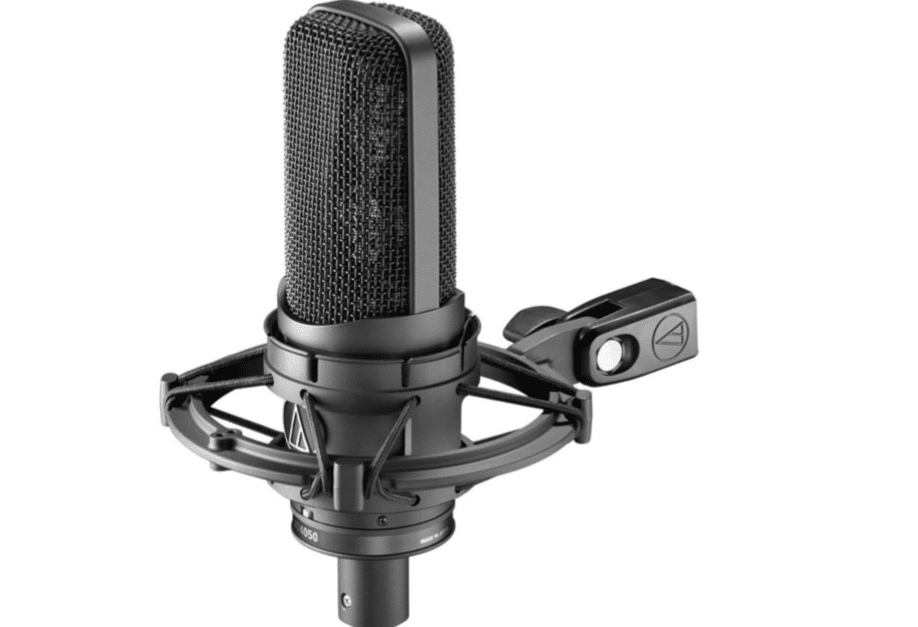
The Audio-Technica AT4050 mic is a large-diaphragm condenser microphone that stands out in my eyes for its sheer versatility alone.
It features three switchable polar patterns, and with a frequency response from 20 Hz to 18 kHz 一 it delivers clear and balanced audio across the frequency spectrum.
With a slight warmth in the mids and transparent highs, I should mention.
I love the 2-micron, vapor-deposited gold diaphragms, which have been aged through a five-step process for consistent performance over the years.
It can handle a maximum SPL of 149 dB (or 159 dB with the 10 dB pad engaged) 一 making it great for loud sources like guitar amps or drums.
Also, the transformerless circuitry minimizes distortion and enhances the vocal mic transient response, so it’s great for fast-paced recording setups.
NOTE: The Audio-Technica AT4050’s self-noise is 17 dBA, which is a bit higher than some other high-end mics, but it’s not a major issue in most recording studio environments.
In a nutshell I’ve found the Audio-Technica AT4050 to be reliable and sturdy, with a build quality that feels premium and features that are high-quality.
Plus the custom shock mount helps reduce handling noise, which is a bonus in studio settings as well, even when producing from your bedroom.
Best Features of this Condenser Microphone
- Large dual-diaphragm design with three polar patterns (omni, cardioid, figure-8)
- Broad frequency response (20 Hz – 18 kHz) with a warm midrange and clear highs
- High max SPL (149 dB) with a -10 dB pad for handling loud sources
- Transformerless circuitry for minimal distortion and accurate transients
- Comes with a custom shock mount and mic stand for reduced handling noise
- Works well with a higher-end audio interface that offers detailed signal processing
- The best mic for recording versatile studio setups, especially vocals and acoustic instruments
#6. Rode NT1-A ($229)

The Rode NT1-A is a popular choice for home studios and budding producers, primarily because its super cheap but gives you surprisingly exceptional sound quality.
As a large-diaphragm condenser microphone with a cardioid polar pattern, it focuses well on vocals and acoustic instruments, capturing detailed mids and smooth highs.
Its frequency response ranges from 20 Hz to 20 kHz, offering a slight boost in the upper frequencies to enhance vocal clarity without any harshness.
One of its most impressive specs is the ultra-low self-noise of just 5 dBA 一 making it one of the quietest mics in its class, which I found cool.
I’ve used the NT1-A for both vocals and acoustic guitar, and it delivers a clear, natural sound that’s hard to beat at this price point.
With a max SPL of 137 dB, it can handle moderate sound levels, but it’s best suited for:
- Vocals
- Softer instruments
- Voice-over work
Rode also includes several useful accessories, like a shock mount, pop filter, and XLR cables, so really it’s the whole package for home studios.
NOTE: It doesn’t have multiple polar patterns, but it’s still one of the best mics for recording vocals when you’re on a budget.
Best Features of this Condenser Microphone
- Large diaphragm with cardioid polar pattern for focused vocal recordings
- Ultra-low self-noise of 5 dBA, ensuring a clean sound
- Frequency response from 20 Hz to 20 kHz with clear, boosted highs
- Max SPL of 137 dB, suitable for moderate vocal and acoustic instrument recording
- Comes with a complete package (shock mount, pop filter, XLR cable)
- The best mic for recording vocals and acoustic instruments, particularly in home studios
#7. sE Electronics sE2200 ($299)
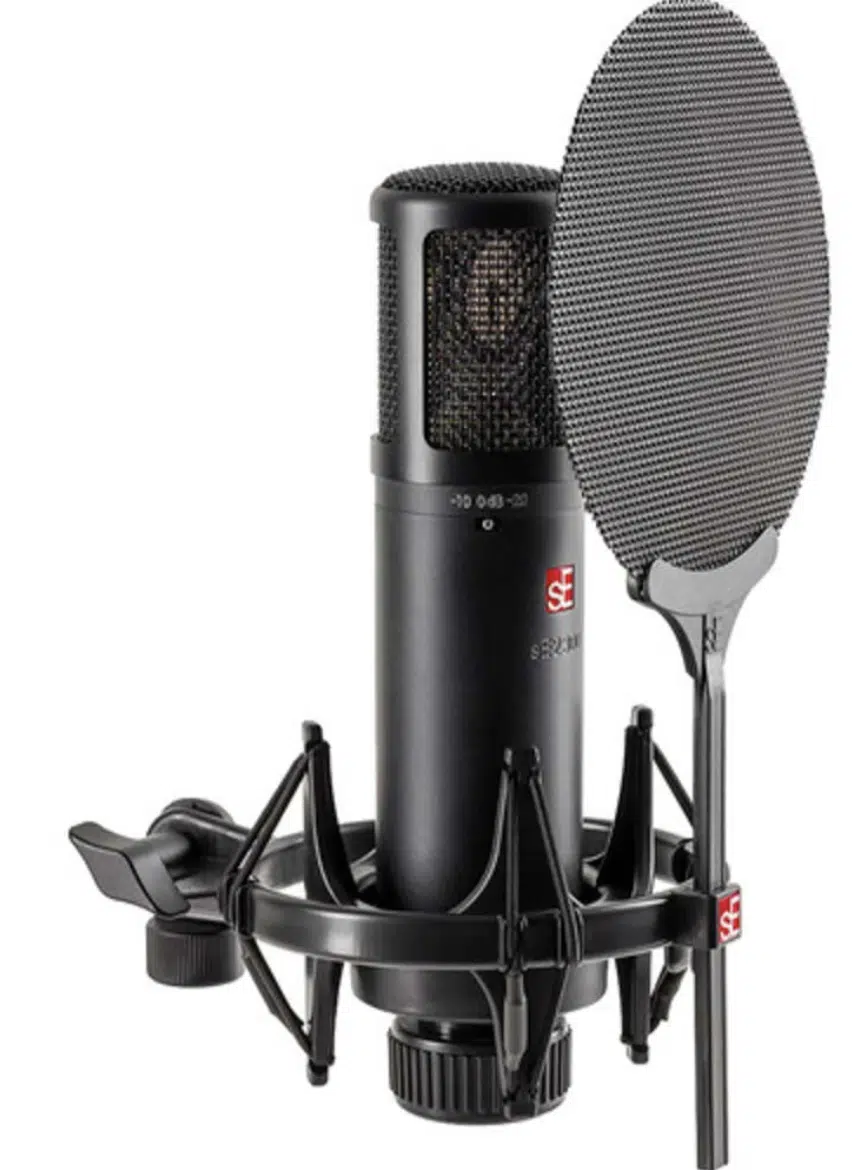
Another super affordable option condenser mic is the the sE Electronics sE2200, which is very well-known in the industry and home studio enthusiasts around the globe.
This popular (cheap) large-diaphragm condenser mic is a favorite among both beginners and professionals, so wherever you are in your journey, it’s got you.
It offers a cardioid polar pattern, which is ideal for focused vocal recordings and isolating the voice from room noise.
The frequency response ranges from 20 Hz to 20 kHz, with a gentle presence boost around 5 kHz that adds clarity to vocals without sounding overly bright.
I’ve used the sE2200 for both vocals and acoustic guitars, and it delivers a clean, detailed sound that sits well in the mix almost every time.
Also, it has a max SPL of 145 dB, so it’s actually capable of handling louder sources like drums or guitar amps as well.
With a self-noise of just 11 dBA, it’s among the quieter options in its price range 一 ensuring clear vocal recordings even in untreated home studios.
The sE2200 includes a shock mount and pop filter, which is a nice bonus for the price so you don’t have to worry much about good isolation and reducing unwanted noise.
Overall it’s a good mic (especially for the money) and it really pays good attention to the little things, which makes it alright in my book.
Best Features of this Condenser Microphone
- Large diaphragm with a cardioid polar pattern for focused sound capture
- Frequency response from 20 Hz – 20 kHz with a presence boost around 5 kHz
- Max SPL of 145 dB, suitable for loud vocal performances and instruments
- Low self-noise (11 dBA) for clear recordings in home studios
- Comes with a shock mount and pop filter, adding value for its price
- The best mic for recording vocals and acoustic guitars in home studio setups
#8. UA Sphere DLX ($1,499)
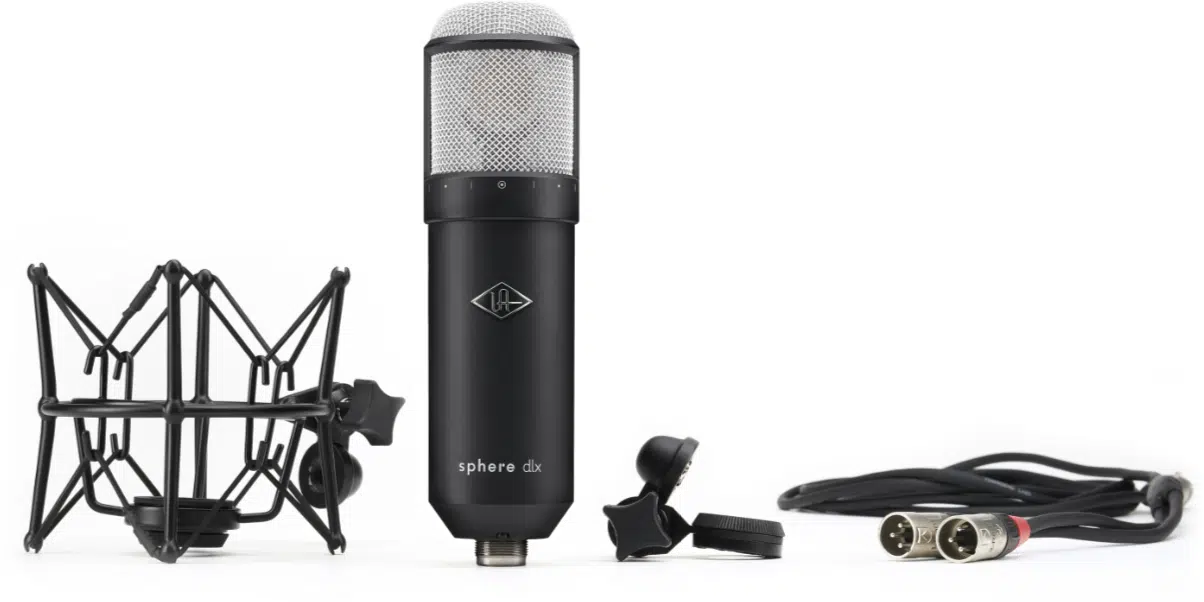
Going back to the high-end options, we have the UA Sphere DLX.
It’s a high-end modeling condenser mic that emulates over 30 classic microphones, so needless to say it’s super versatile for all your recording needs.
It features dual large diaphragms and offers multiple polar patterns 一 including cardioid, omnidirectional, figure-8, and more (like all the best options do).
The real magic of this vocal mic lies in its modeling capabilities, which allow you to switch between different mic models in real time for epic sound-shaping.
I’ve found this vocal mic to be useful when working in DAWs, as the software integration allows for instant adjustments to:
- Polar patterns
- Mic models
- Even off-axis correction
The build quality feels premium, and its versatility makes it a standout choice for both professional studios and advanced home setups.
Oh, and the UA Sphere DLX’s frequency response is flat from 20 Hz to 20 kHz and it can handle a max SPL of 140 dB.
So even if you’re working with louder sources like drums or amplified instruments, it’s solid.
Best Features of this Condenser Microphone
- Dual large diaphragms with multiple polar patterns for extensive flexibility
- Frequency response of 20 Hz – 20 kHz with flat, accurate sound reproduction
- Max SPL of 140 dB, suitable for a variety of sound sources
- When it comes to vocal microphones, it’s a solid choice
- Modeling capabilities to emulate over 30 classic mics, enhancing versatility
- Software integration for real-time adjustments and sound shaping
- Other omnidirectional mics can’t compare
- The best mic for recording a wide range of vocals and instruments with customizable sound options
Best Dynamic Microphones for Recording
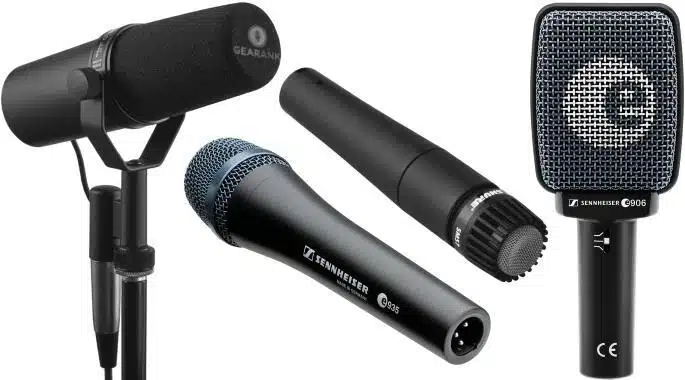
Dynamic microphones, as opposed to condenser microphones, are more about durability and versatility. They excel at handling high sound pressure levels and rejecting background noise so they’re perfect for loud sources like electric guitars or live vocals. Plus, they can help your vocals and instruments sound punchy and consistent, even in noisy or untreated recording environments. For this next section, we’re breaking down the top dynamic microphones.
#1. Shure SM7B ($399)
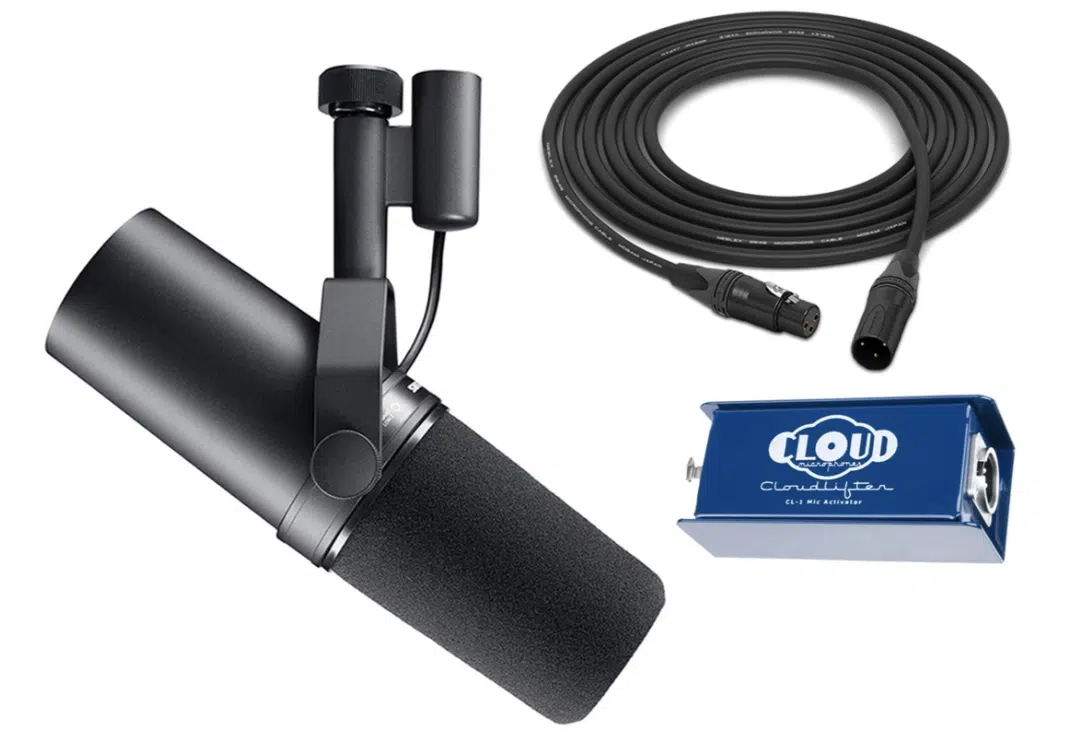
Starting with an affordable, classic in the world of dynamic microphones/vocal microphones, we have the Shure SM7B (often called a “recording studio staple”).
Initially released in 1973 and popularized by Michael Jackson’s “Thriller,” it remains a go-to choice for:
- Vocals
- Podcasts
- Even instrument recording
One of the main reasons I love this dynamic mic is its ability to deliver clear and warm sound, thanks to its flat frequency response ranging from 50 Hz to 20 kHz.
It has built-in EQ switches for a bass roll-off and a mid-range boost, so it works with all different vocal styles.
Plus the cardioid polar pattern offers excellent off-axis rejection, which makes it ideal for noisy recording studios or untreated rooms.
It’s not the most sensitive mic (-59 dBV/Pa), I can’t lie, so pairing it with a gain booster like the Cloudlifter (shown above) is often necessary for optimal performance.
The SM7B also features internal air suspension 一 reducing vibrations and minimizing handling noise, which is awesome.
It’s a bit heavy (weighing 1.69 lbs) and the sturdy build gives it a premium feel that few mics can outdo, all without breaking the bank.
If you’re after professional sound quality with minimal background noise, this dynamic microphone is a great fit, hands down.
Best Features of this Dynamic Microphone/Vocal Microphone
- Dynamic cardioid mic with flat frequency response (50 Hz – 20 kHz)
- Built-in EQ switches for bass roll-off and presence boost
- Excellent noise rejection, ideal for untreated recording studios
- Works well with any audio interface that has sufficient gain
- Internal shock mount for reduced handling noise and vibrations
- Best mic for recording clear vocals and minimizing room noise
- One of my favorite dynamic mics around
#2. Sennheiser MD421-II ($379)
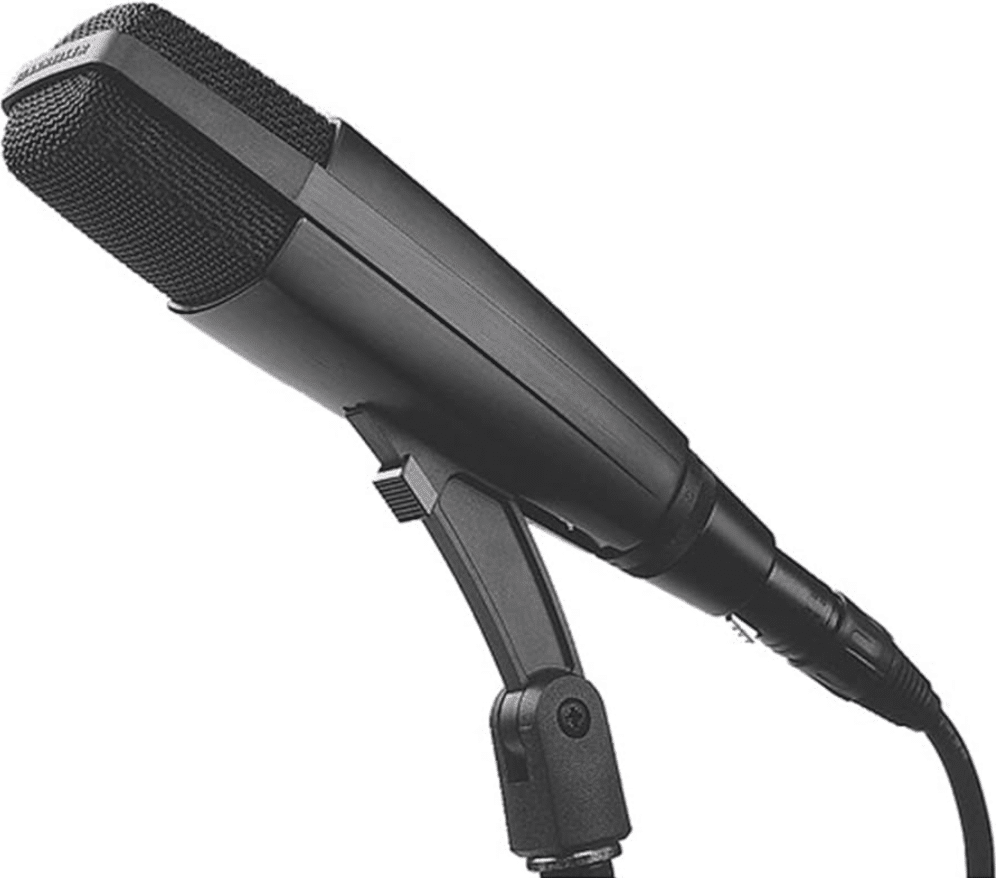
The Sennheiser MD421-II is another one of those affordable dynamic mics, loved for its clear, punchy sound across various recording scenarios.
It features a cardioid polar pattern that excels at isolating sound sources, making it very useful for recording vocals, drums, and guitar amps.
It has a super wide frequency response/frequency range from 30 Hz to 17 kHz, with a noticeable midrange boost that adds warmth to vocals and detail to instruments.
One of my favorite features is the five-step bass roll-off switch, which allows for tweaked low-frequency response to fit different environments and sources.
I’ve used it on drums and vocals, and its ability to handle high SPLs (up to 160 dB) is extremely impressive for the price, so loud sources won’t be a problem.
The MD421-II’s rugged build and metal body ensure durability, but its size and weight can make positioning a bit challenging, so just keep that in mind.
Despite its size, it provides clear sound, making it a valuable addition to any mic locker.
Best Features of this Dynamic Microphone
- Cardioid polar pattern with a frequency response of 30 Hz – 17 kHz
- Five-step bass roll-off switch for tailored low-end response
- It’s a reliable option like other Sennheiser mics; great budget mic
- Handles up to 160 dB SPL, great for loud sources like drums and guitar amps
- This vocal microphone has a durable metal construction for long-lasting use
- Best mic for recording drums and vocals/voice sounds with midrange warmth
#3. Electro-Voice RE20 ($499)
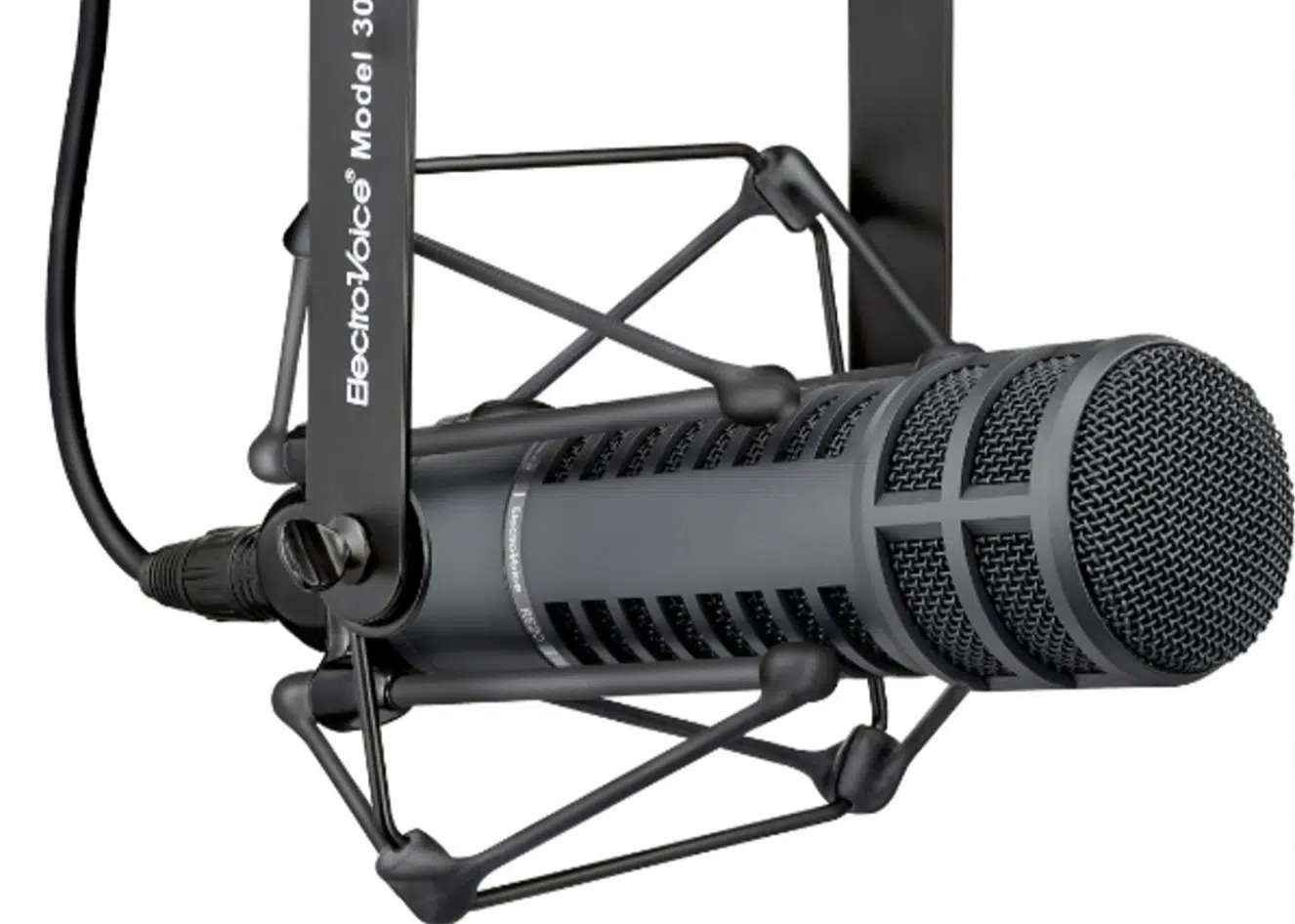
The Electro-Voice RE20 is another legendary dynamic vocal microphone, widely used in broadcasting and studios for its clarity and detailed sound.
Its large-diaphragm design, paired with a cardioid polar pattern, delivers a natural sound with a frequency response of 45 Hz – 18 kHz.
The RE20 is well-known for its Variable-D technology, which reduces the proximity effect, so you’ll keep consistent sound quality even at close distances.
I love this feature, especially for vocals and radio broadcasting, as it helps avoid overly boomy tones, which can be infuriating, am I right?
This dynamic mic can handle up to 160 dB SPL, making it capable of capturing loud sound sources like kick drums and bass amps.
Side note, because we mentioned kick drums, if you’re looking for some kick drum tips and secrets, we got you covered.
Plus its internal shock mount and steel body offer durability and reduced handling noise as well.
While it’s heavier than many mics, weighing 1.6 lbs, it’s highly reliable and well-suited for recording studios and broadcasting purposes.
Especially when you value clarity and minimal background noise above all else.
Best Features of this Dynamic Microphone
- Large diaphragm with cardioid polar pattern for consistent sound
- Frequency response of 45 Hz – 18 kHz with Variable-D technology to reduce proximity effect
- High max SPL (160 dB), ideal for loud vocals and instruments
- Internal shock mount and steel body for durability and reduced handling noise
- Performs well with any audio interface like any best microphone
- One of the best dynamic mics for recording clear vocals and instruments
#4. Shure SM58 (~$100)
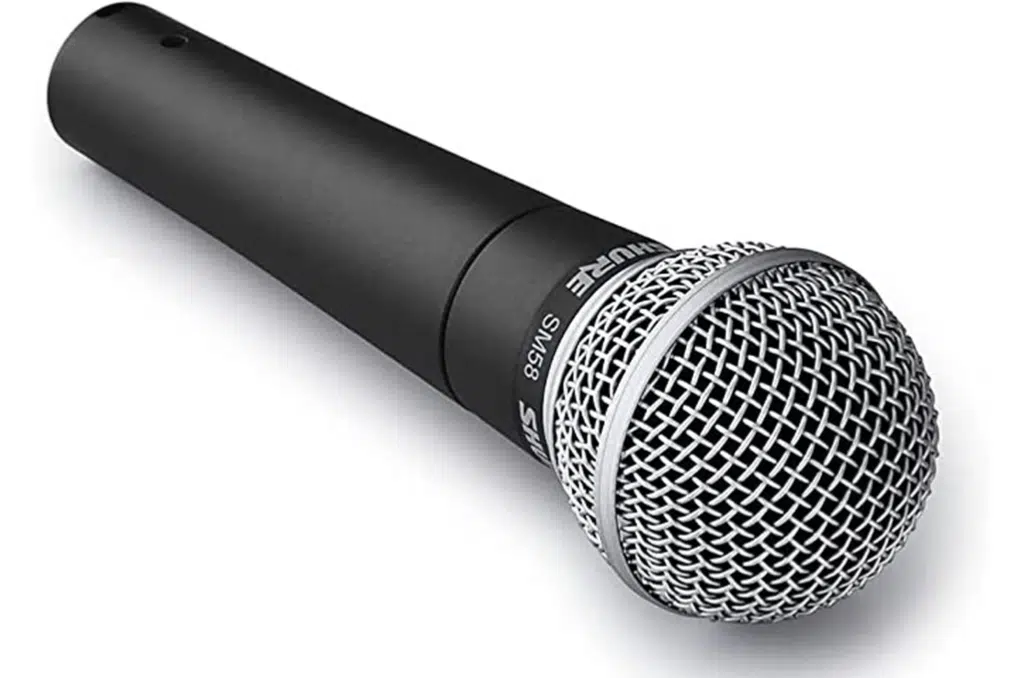
Perhaps the cheapest dynamic mic I would ever advise you to buy: the Shure SM58.
It’s the epitome of a classic dynamic mic, revered for its versatility and durability and literally known as the “workhorse” of microphones believe it or not.
This great mic is widely used for live vocals, but I’ve also had good experiences using it for recording studio projects as well.
It features a cardioid polar pattern, which focuses sound pickup in front of the vocal mic while rejecting background noise, making it perfect for untreated rooms/outdoor gigs.
NOTE: Its frequency response ranges from 50 Hz to 15 kHz 一 offering a balanced tone with a gentle presence boost in the midrange.
This boost helps vocals sound more present and clear, especially in live mixes.
With a max SPL of 150 dB, it can handle loud sources like guitar amps or even drum kits like all of our other best mic for recording options.
One of the SM58’s best features in my opinion is its rugged metal construction… it’s literally famous for surviving all sorts of mishaps without losing sound quality.
While it may not have the same high-end detail as condenser mics, it’s a reliable choice for vocals that need to cut through noisy environments without fuss.
Best Features of this Dynamic Microphone
- Cardioid polar pattern for effective noise rejection
- Frequency response from 50 Hz to 15 kHz, with a midrange presence boost
- Can handle up to 150 dB SPL, suitable for loud sources
- Rugged metal construction for durability in any setting
- Best mic for recording live vocals with clear, present sound and minimal background noise
Best Tube Microphones
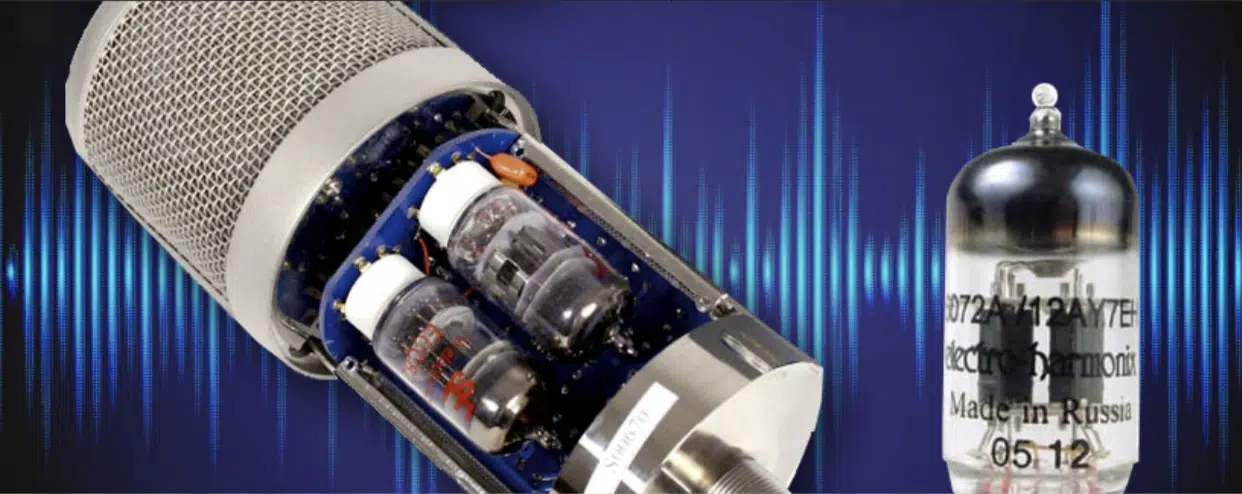
In a league of its own, tube microphones are renowned for their warmth and vintage character. They enhance vocal depth and add a smooth, musical quality to recordings. Plus, help with bringing out the natural harmonics of vocals and instruments for a sound that’s hard to replicate with other mics. The following are my favorite 2.
#1. Neumann U67 Reissue ($7,400)
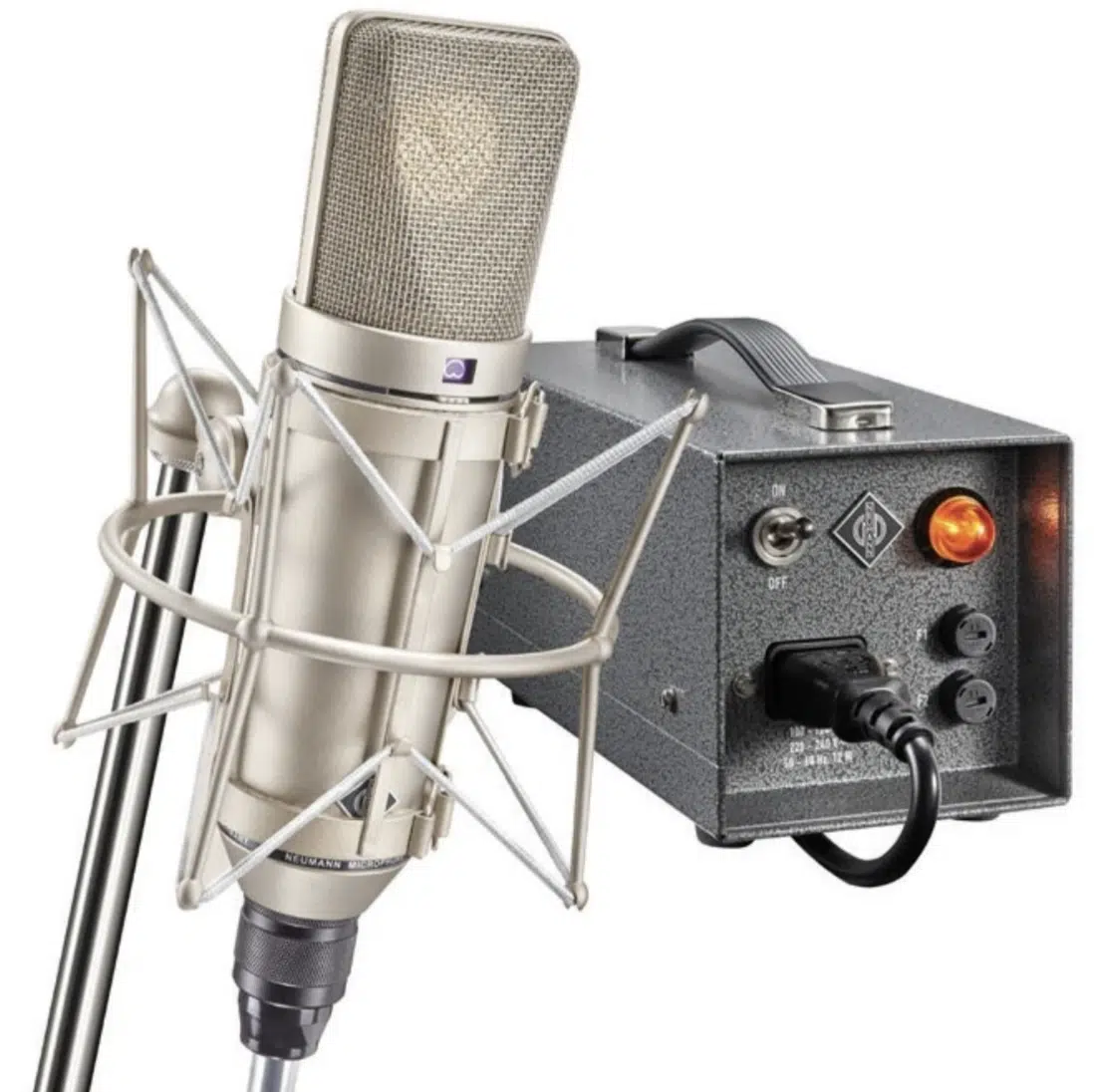
I know, I know, the price tag is a little overwhelming, but the Neumann U67 Reissue is one of the most impressive replication mics I’ve ever used in my entire life.
It’s a faithful recreation of the iconic U67, originally released in 1960 and considered one of the best tube microphones ever made.
I freakin’ love how it adds a smooth, warm tube shimmer to vocals 一 enhancing their richness without sounding overly bright.
This tube microphone has a max SPL of 124 dB (with the pad engaged) so it’s great for handling both delicate vocals and louder sound sources without distortion.
The Reissue also includes modern components, like the redesigned NU67 V power supply, which improves efficiency and compatibility with today’s studios.
When it comes to aesthetics and build, the U67’s classic design remains intact 一 adding a touch of prestige to any studio.
I’ve found this tube mic to be a “desert island” choice… It’s one of those rare microphones that works across genres while maintaining an emotional, musical sound.
And believe me, there are many ways to finance it if you’re really looking for the absolute best tube mic in the game, hands down.
NOTE: This best microphone features the three polar patterns you know about by now and has a frequency response of 20 Hz to 20 kHz.
Best Features of this Tube Condenser Microphone
- One of the best expensive microphones in the game
- Three polar patterns (cardioid, omni, figure-8) for versatile sound capture
- Frequency response of 20 Hz to 20 kHz with warm, tube-driven highs
- Max SPL of 124 dB, suitable for a variety of vocal styles and instruments
- Redesigned power supply for modern compatibility (unique for best microphones)
- Best mic for recording rich, vintage-style vocals and acoustic instruments (like an acoustic guitar)
#2. Rode NTK ($599)
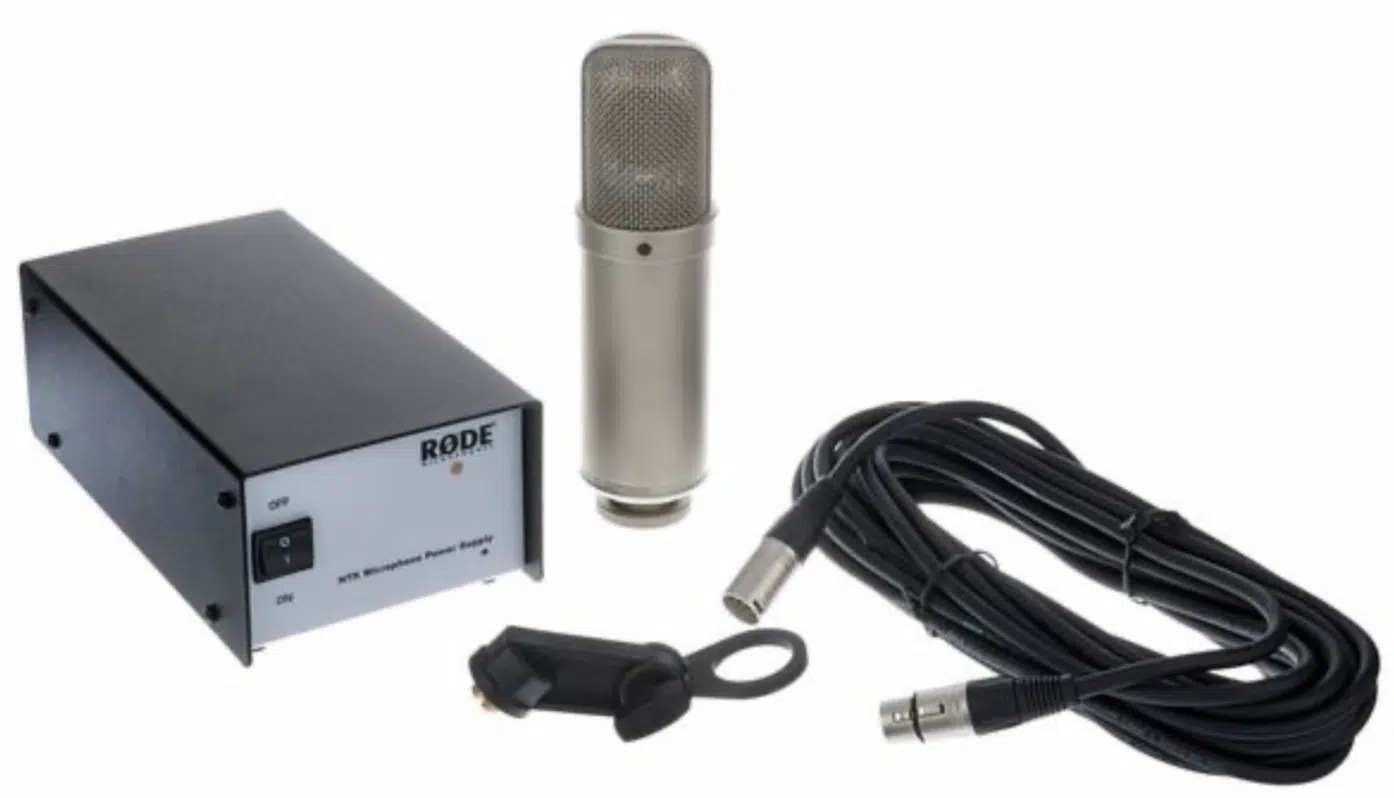
After that shocking pricetag, I’d be remiss if I didn’t offer a more realistic tube microphone choice: the Rode NTK.
It’s the best tube condenser mic in its price range, delivering a warm, vintage-like sound that’s unmatched (which is why it’s so popular among most home studio owners).
It features a cardioid polar pattern, focusing on the sound source while reducing background noise 一 ideal for untreated recording rooms.
Its frequency response of 20 Hz to 20 kHz offers a slightly pronounced midrange, so it’ll certainly give your vocals nice presence and clarity.
With a max SPL of 158 dB, the NTK is capable of handling louder sources, such as drums or electric guitar amps, making it solid for more than just vocals.
I’ve actually used this vocal microphone in both home and professional settings, and its sound is surprisingly warm and detailed for its price.
While it doesn’t have the same level of refinement as higher-end tube mics, it still adds a pleasant tube character to vocals and acoustic instruments.
The NTK comes with its own power supply, which makes sure you have a clean signal output and minimal noise.
Best Features of this Tube Condenser Microphone
- Cardioid polar pattern for focused sound capture with minimal noise
- Frequency response from 20 Hz to 20 kHz with a warm midrange (great sound)
- High max SPL (158 dB), suitable for loud vocals and instruments
- Comes with a dedicated power supply for clear signal output
- Excellent when paired with a basic audio interface, thanks to its low self-noise
- Best mic for recording warm, vintage-style vocals in home studios
Best Ribbon Microphone: Royer R-121 ($1,495)
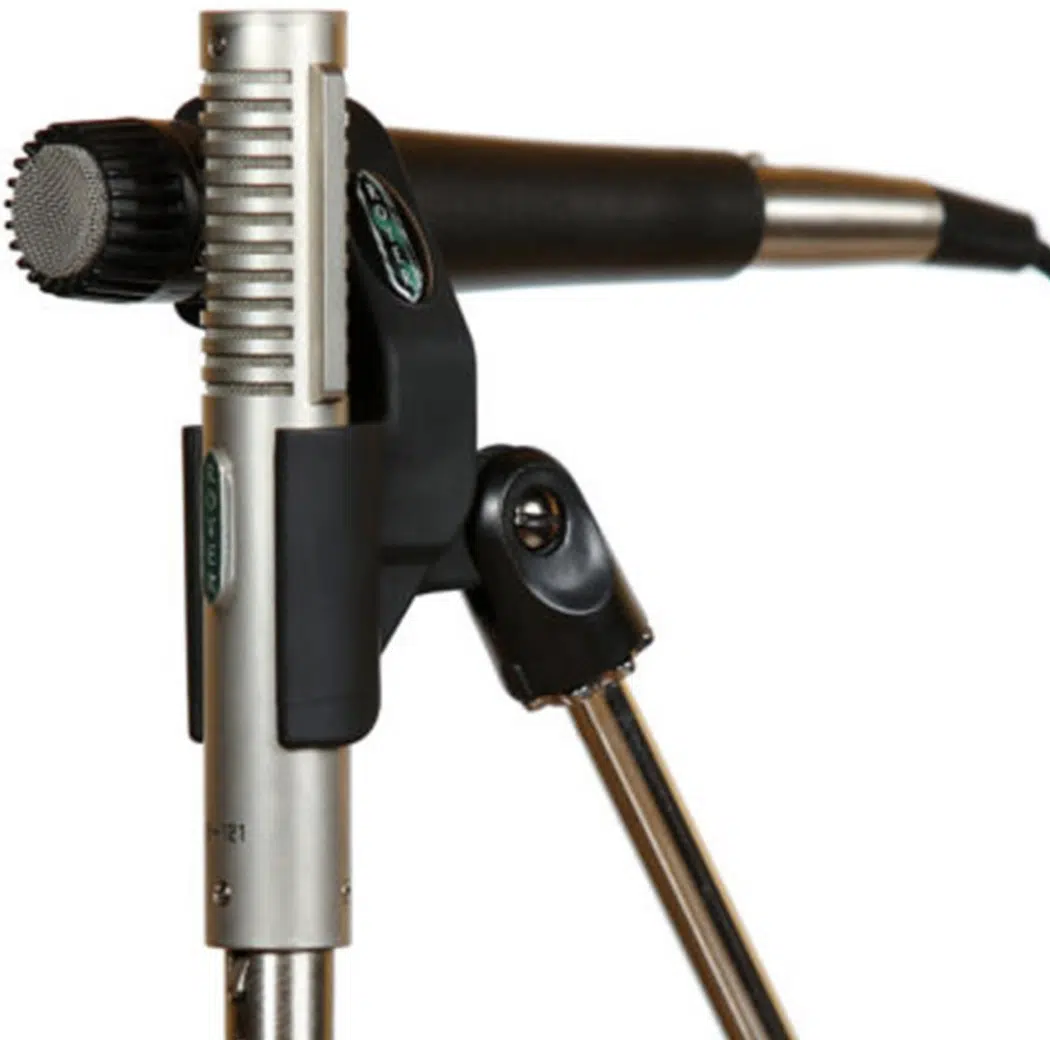
The Royer R-121 is a modern classic in the world of ribbon mics, known for its warm, natural sound.
It uses a figure-8 polar pattern, which captures sound from the front and back while rejecting side noise, making it ideal for both recording studio uses and live recordings.
The R-121 has a frequency response from 30 Hz to 15 kHz for smooth highs and rich low frequencies without distortion, even at high SPLs (up to 135 dB).
One of my favorite things is its ability to maintain clarity when close-miking loud sources like electric guitar amps or brass instruments.
Despite being a ribbon mic, it has a rugged build and is designed to handle the demands of professional use 一 including accidental phantom power protection.
Side note, if you want to learn all about phantom power, we got you covered.
I’ve found the R-121 to be EQ-friendly, allowing for high boosts without adding harshness, which is a super unique trait for ribbon mics.
It’s an excellent choice for capturing lifelike vocal recordings, acoustic guitars, and even drum room sounds, adding a natural warmth to the mix that many condensers can’t.
Best Features of this Ribbon Microphone
- Figure-8 polar pattern for front and back sound capture with side rejection
- Frequency response from 30 Hz to 15 kHz with smooth, natural tone
- Handles high SPLs (up to 135 dB) without distortion
- EQ-friendly, allowing for boosts without harshness
- Best mic for recording warm, natural vocals and electric guitars with minimal coloration
Best USB Microphone: Shure MV7 ($279)
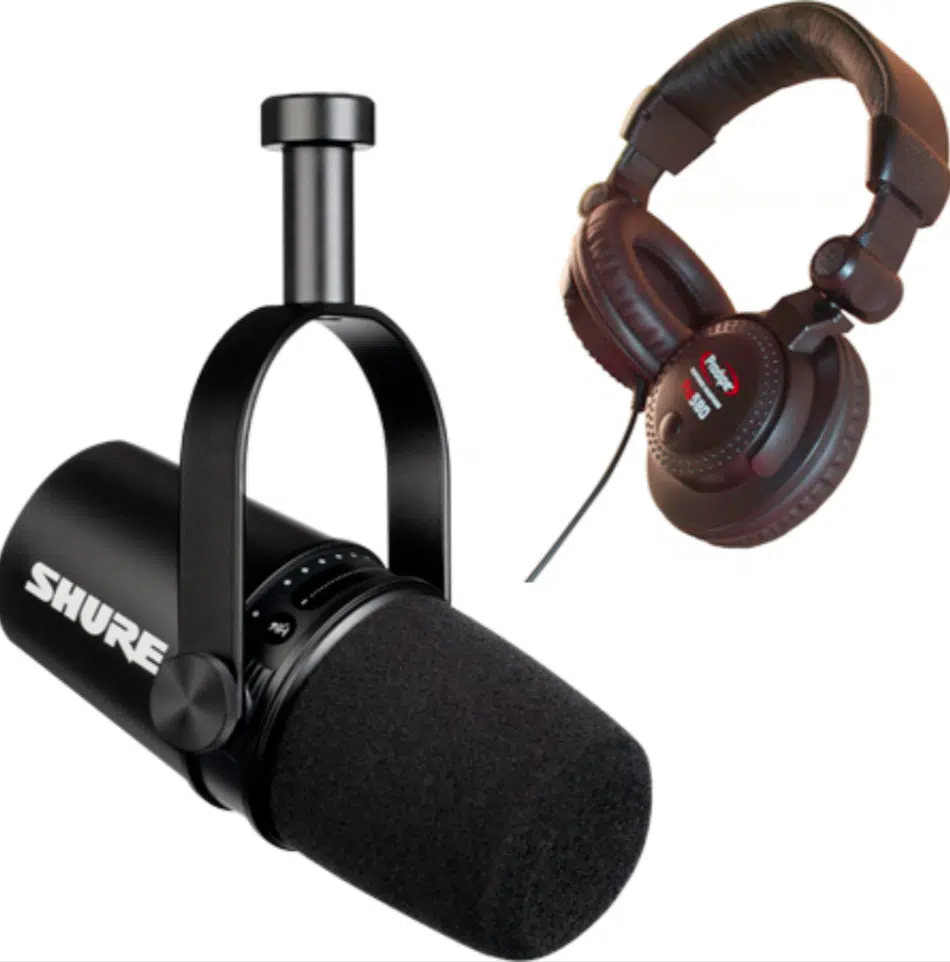
The Shure MV7 is one of my absolute favorite USB microphones for its dual connectivity (USB and XLR cables), making it adaptable for various recording setups.
It’s a dynamic mic with a cardioid polar pattern, which rocks at isolating vocals from background noise, which makes it perfect for:
- Home studios
- Podcast recording
- Music production
Keep in mind, though, that it’s best for podcasting over everything else.
It has a frequency response of 50 Hz to 16 kHz, providing clear mids and a balanced low end, though the highs are slightly rolled off to avoid harshness.
The MV7 features Shure’s Voice Isolation Technology, which keeps your voice at the forefront, even in noisy environments—a huge plus for podcasters and streamers.
I love the MOTIV Mix software, which lets you adjust the sound signature of the vocal mic, gain, EQ, and even add digital processing like compression and reverb.
The built-in touch panel for real-time adjustments and LED customization is a fun touch, but I’ve found the digital pop filter to be slightly less effective than a traditional one.
Especially when I tried recording my vocalist’s more ‘loud’ vocal sections.
Overall, it’s a fantastic USB mic that’s easy to set up and delivers professional audio quality, whether you’re using it in a recording studio or on the go.
Best Features of this USB Microphone
- Dual USB and XLR outputs for versatile connectivity
- Cardioid polar pattern with Voice Isolation Technology to reduce background noise
- Frequency response of 50 Hz to 16 kHz, with clear mids and balanced lows
- Real-time DSP options like compression, reverb, and a digital pop filter via the MOTIV Mix app
- Best mic for recording clear vocals in less-than-ideal spaces, making it perfect for podcasts and music production
Best Mic for Recording: Final Thoughts
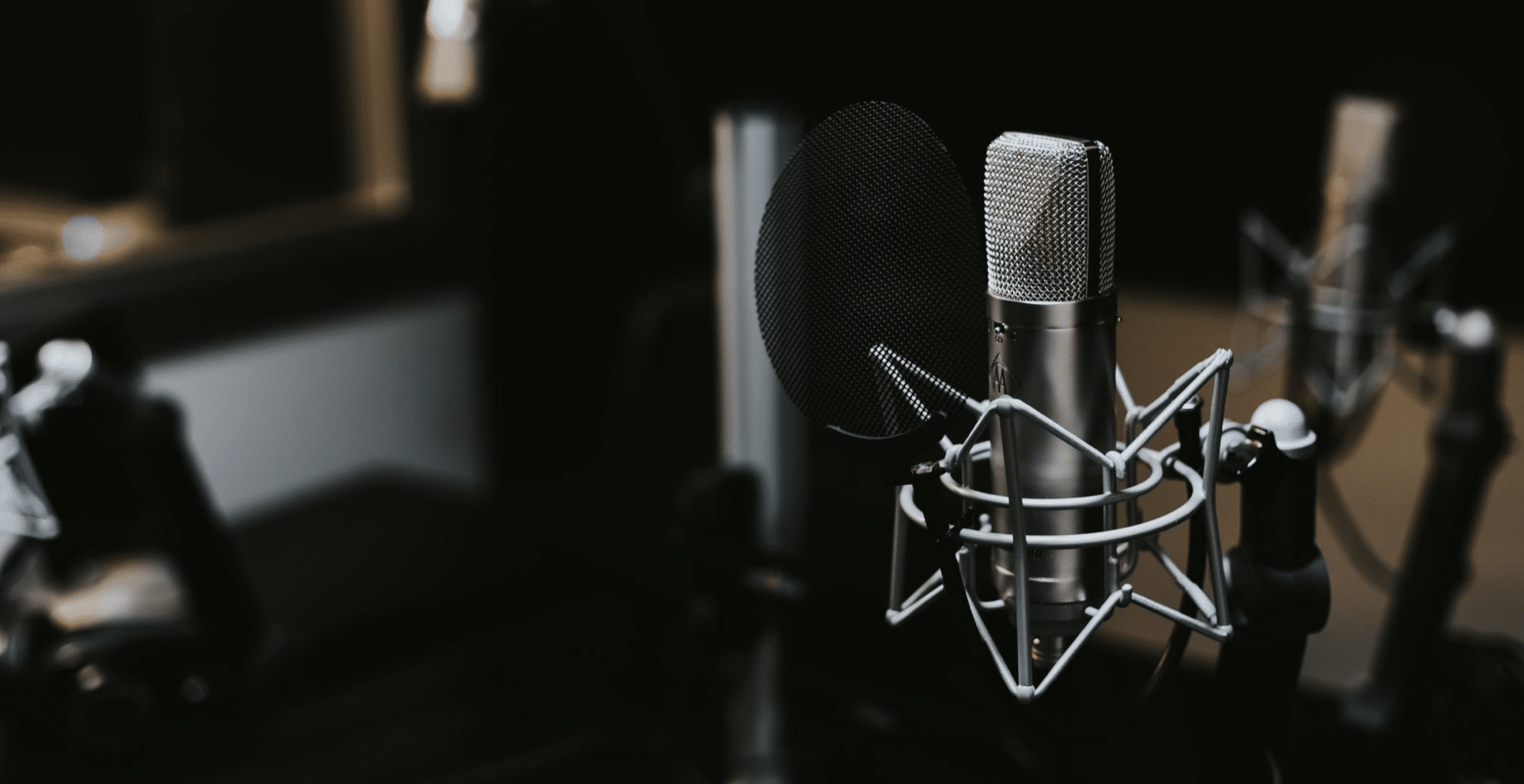
So, there you have it 一 my absolute favorite mics for recording (including the best mic for recording in each category).
Whether you’re looking for a sick vocal mic or a dope acoustic instrument mic, this list covers it all; it really boils down to your specific needs and recording environment.
Plus, factors like sound quality, durability, and flexibility will help narrow your options, but I guarantee one on our list is right for you.
As a special bonus, check out these show-stopping Free Vocal Samples pack, which contains 20 royalty-free vocal loops, chops, and one-shots.
These professionally recorded and processed samples are ready to enhance your tracks, making them sound polished and radio-ready without additional work.
They’re perfect for producers looking for high-quality vocal samples in all the most popular genres like hip-hop, pop, and EDM.
Remember, no matter which mic you choose, the key is to experiment and stay creative.
The right mic can make all the difference in your recordings, so go ahead and make your tracks shine with these amazing options.
Until next time…







Leave a Reply
You must belogged in to post a comment.